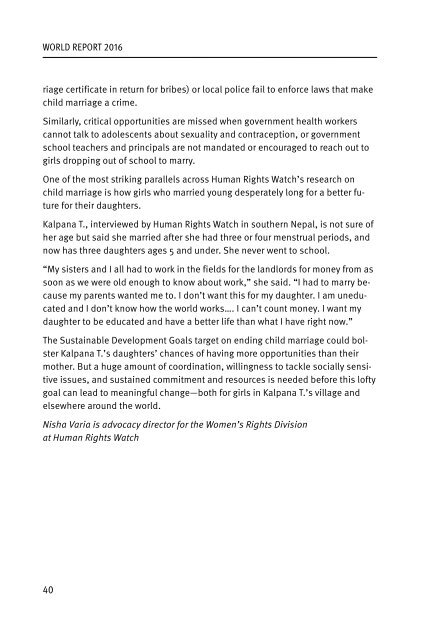Create successful ePaper yourself
Turn your PDF publications into a flip-book with our unique Google optimized e-Paper software.
WORLD REPORT 2016<br />
HUMAN RIGHTS WATCH<br />
riage certificate in return for bribes) or local police fail to enforce laws that make<br />
child marriage a crime.<br />
Similarly, critical opportunities are missed when government health workers<br />
cannot talk to adolescents about sexuality and contraception, or government<br />
school teachers and principals are not mandated or encouraged to reach out to<br />
girls dropping out of school to marry.<br />
One of the most striking parallels across Human Rights Watch’s research on<br />
child marriage is how girls who married young desperately long for a better future<br />
for their daughters.<br />
Kalpana T., interviewed by Human Rights Watch in southern Nepal, is not sure of<br />
her age but said she married after she had three or four menstrual periods, and<br />
now has three daughters ages 5 and under. She never went to school.<br />
“My sisters and I all had to work in the fields for the landlords for money from as<br />
soon as we were old enough to know about work,” she said. “I had to marry because<br />
my parents wanted me to. I don’t want this for my daughter. I am uneducated<br />
and I don’t know how the world works…. I can’t count money. I want my<br />
daughter to be educated and have a better life than what I have right now.”<br />
The Sustainable Development Goals target on ending child marriage could bolster<br />
Kalpana T.’s daughters’ chances of having more opportunities than their<br />
mother. But a huge amount of coordination, willingness to tackle socially sensitive<br />
issues, and sustained commitment and resources is needed before this lofty<br />
goal can lead to meaningful change—both for girls in Kalpana T.’s village and<br />
elsewhere around the world.<br />
Nisha Varia is advocacy director for the Women’s Rights Division<br />
at Human Rights Watch<br />
Children Behind Bars:<br />
The Global Overuse of Detention of Children<br />
By Michael Bochenek<br />
Shortly after 16-year-old T.W. was booked into Florida’s Polk County Jail in February<br />
2012, his three cellmates punched him, whipped him with wet towels, and<br />
nearly strangled him with a pillowcase. They then urinated on him, sprayed his<br />
face with cleaning fluid, and stripped him naked before wrapping a sheet around<br />
his neck, tying the other end around the window bar, and pulling so tight he lost<br />
consciousness. They repeated this attack three times over the course of several<br />
hours without jail guards on regular rounds even noticing, a federal magistrate<br />
judge found.<br />
Around the world, children languish behind bars, sometimes for protracted periods.<br />
In many cases, as with T.W., they face brutal and inhumane conditions.<br />
The lack of record-keeping and a wide array of institutions means that the number<br />
of children held worldwide in such environments is not known. The United<br />
Nations children’s fund, UNICEF, has estimated that more than 1 million children<br />
are behind bars around the world. Many are held in decrepit, abusive, and demeaning<br />
conditions, deprived of education, access to meaningful activities, and<br />
regular contact with the outside world.<br />
Many of these children—and adults who were convicted of crimes committed<br />
when they were children—have received excessive or disproportionate sentences<br />
that violate international law, which requires that imprisonment of children<br />
be in “conformity with the law and shall be used only as a measure of last<br />
resort and for the shortest appropriate period of time.”<br />
Others are held for acts that should not be crimes at all, such as skipping<br />
school, running away from home, having consensual sex, and seeking or having<br />
an abortion. Some have never been tried for their alleged crimes; others are<br />
tried as if they were adults and, when convicted, sent to serve time in adult<br />
prisons.<br />
40<br />
41


